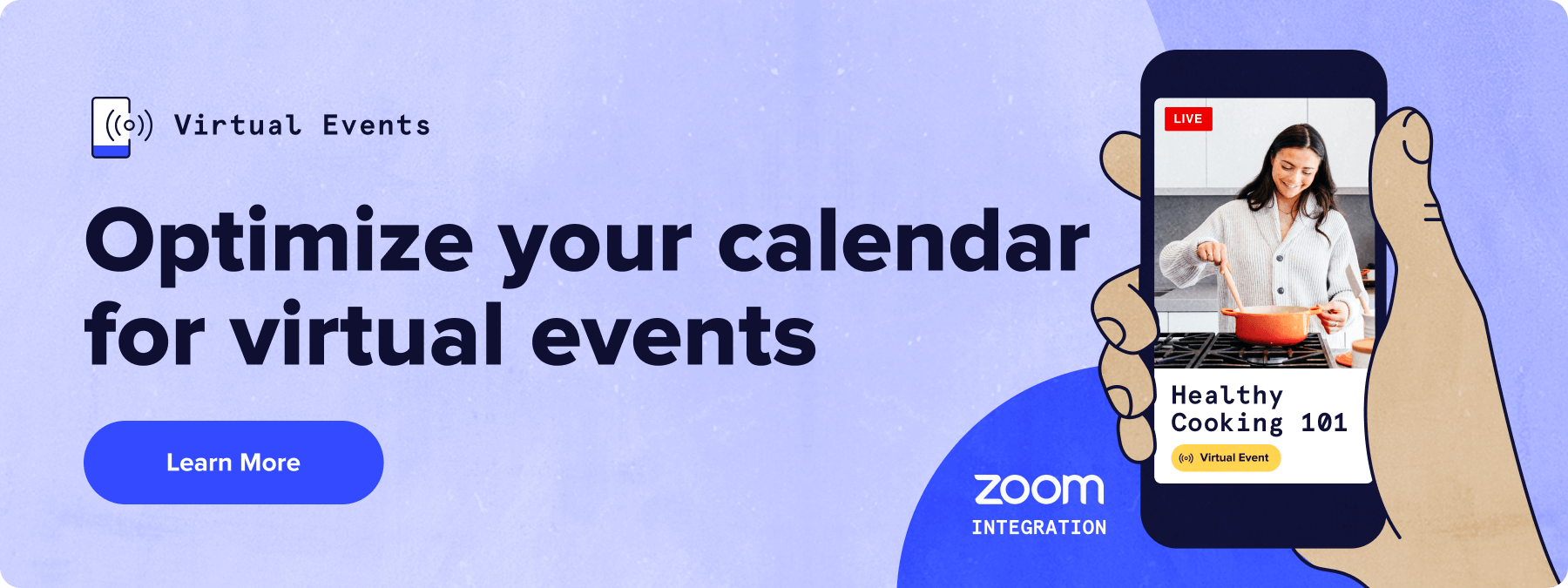Virtual Events: A Getting Started Guide for 2021

This post was originally published on March 18, 2020. It was last updated on Jan. 13, 2021.
After you’ve made the difficult decision to cancel your in-person event and the dust starts to settle, you might be wondering how to switch your get-together to a virtual event.
These days, we’re lucky to have a plethora of tools and technology to help facilitate virtual gatherings, from Google Hangouts to Zoom to livestreaming on social media. But before you can decide which tool to use, you need to outline a high-level plan for taking your event from IRL to online.
In this post, we’ll help you start thinking about the big questions you need to answer as you reconfigure your event for a virtual audience.
Ask yourself: What is the value that your business/event brings to your audience?
This is a lofty question, so let’s break it down. It helps to think about how you define your business or event. Does it fall into one of these categories?
- Community
- Education
- Physical goods
- Entertainment
- Service
For example, if you host community events, your value might be that you bring people together around a common cause or interest. If your business sells physical goods, your value is providing people with a particular item that they need or want.
Your business might fall into multiple categories or different categories at different times, so don’t worry about getting too narrow as you define your value. Just use this as a prompt and a starting point to outline the benefit you offer to your audience/customers. Whether you’re hosting an event in-person or on the internet, your value remains your north star. It’s what you want people to take away from the experience, regardless of where they attend your event.
How does your value translate virtually?
There’s no one-size-fits-all solution for hosting virtual events. This is where we start to get into the nitty-gritty of what your own event might look like after you move it online.
As you weigh your options, keep your value at the forefront. Use it to guide decisions about how to run your virtual event.
Here are a few examples to help get your wheels turning:
- Education: A Spanish class for adult learners was supposed to be held weekly at a community college. The instructor moves the course online using live or recorded lectures delivered via webinar. She also creates a Slack channel where students can discuss the week’s assignments and ask questions. This experience delivers on its value of teaching a new skill in a collaborative setting.
- Community: A parenting group usually meets at a local coffee shop every Monday. Since the coffee shop has closed, the group sets up a weekly private Zoom meeting, and the organizer comes prepared with ice-breaker questions to get the conversation going.
- Physical goods: A popular home decor boutique decides to shut its doors. The owners have to cancel a flash sale that was planned for the upcoming weekend, so they move the sale online, posting items in their online store and/or on Instagram where shoppers can claim items on a first-come, first-serve basis. Shoppers still get the local, boutique shopping experience they wanted, just in an online form rather than in the store.
- Entertainment: A band planned to perform at a bar, but the event was canceled. They decide to livestream their performance on Instagram, and viewers can leave “tips” by sending money on Venmo or Paypal. Audience members still benefit from the value of enjoying a live performance and connecting with other audience members through Instagram’s live commenting/chat feature.
- Service: A local bank planned to host an in-person tax workshop where attendees would learn how to fill out their tax return forms. The organizers decide to switch to a webinar format, using a pre-recorded presentation, then opening up for audience questions at the end. They deliver on their promise to provide valuable information and answer specific questions from attendees.
What tools do you need?
There are tons of apps and tools for setting up video calls, webinars, and remote collaboration—we recommend checking out some of the resources and lists from Event Manager Blog if you want a comprehensive overview of the options available.
If your needs are fairly simple, you can probably get by with a free tool like Google Hangouts, Facetime, or livestreaming on social media platforms such as Facebook and Instagram. If you will be hosting lots of events and you need additional features, look into paid tools like GoToMeeting/GoToWebinar or Adobe Connect.
Build in a little extra time (and compassion) for the transition.
We’re lucky to live in an age where it’s easier than ever to connect with each other through our screens, but making the move to a virtual event is a challenge nevertheless. The switch forces us to completely reconfigure an event that we intended to hold face-to-face, which means some things might not go as planned—and that’s okay. Remember to be patient with yourself and do your best to expect the unexpected.
In the meantime, The Events Calendar team has your back. Don’t hesitate to reach out if there’s any way we can help, or if you want to learn more about our suite of WordPress plugins for powering your events calendar, ticket sales, email communications, and more.
